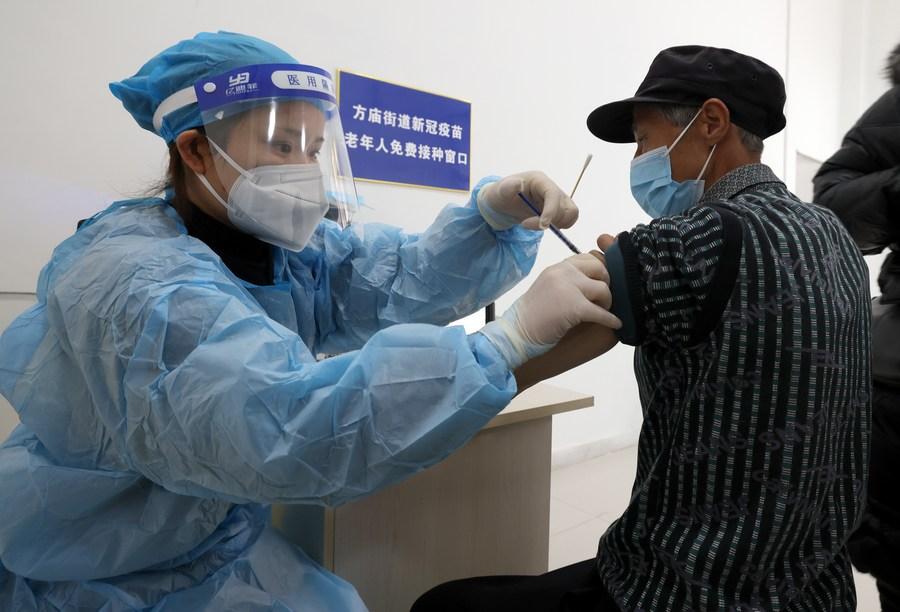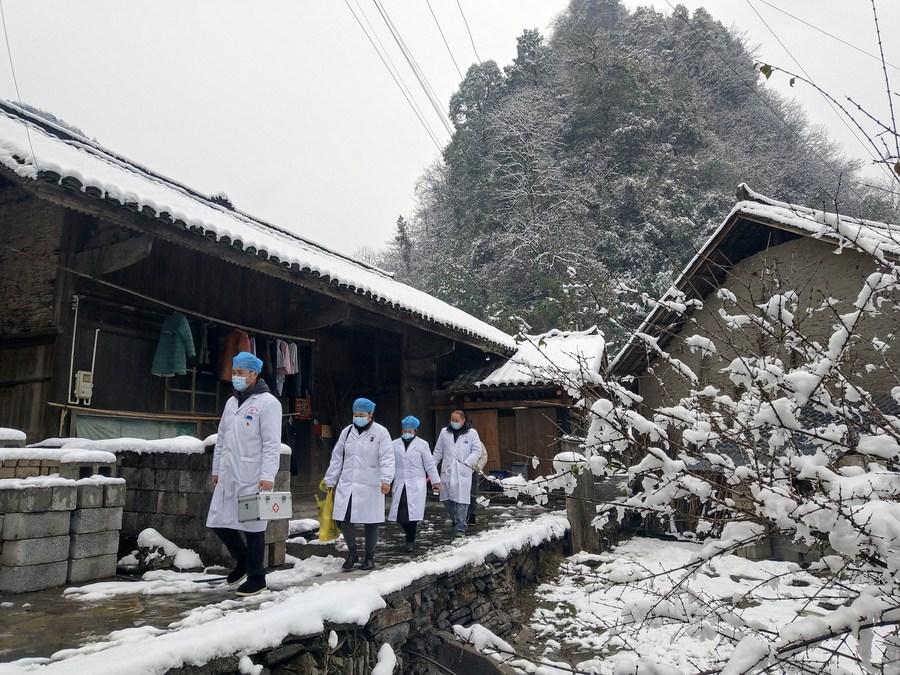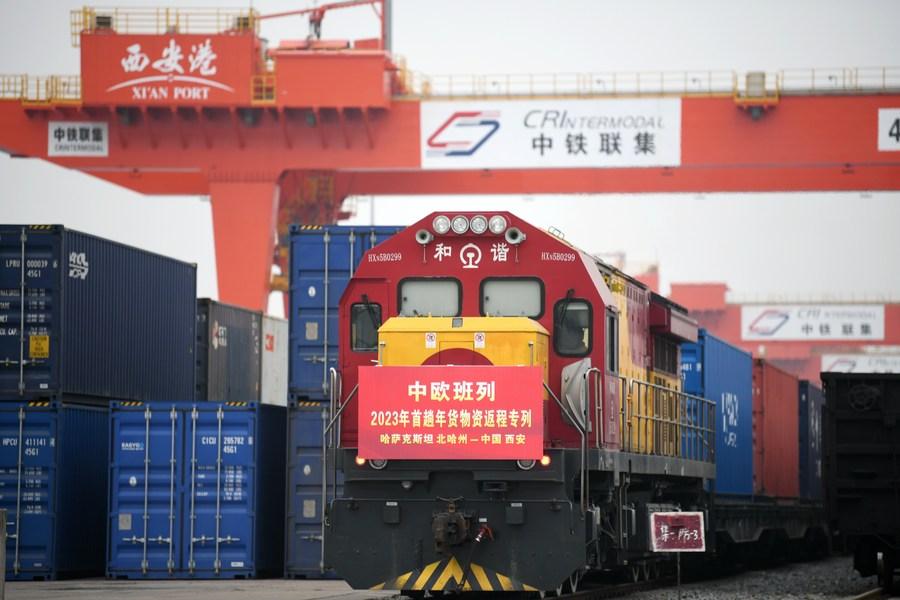
Passengers wait to board trains at Shenzhen North Railway Station in Shenzhen, south China's Guangdong Province, Jan. 18, 2023. (Xinhua/Mao Siqian)
* Over the past three years, China made the best efforts to save lives and protect public health, while keeping the social and economic impacts of the pandemic at the lowest possible levels.
* China has prevented widespread infections caused by the more pathogenic original strain of SARS-CoV-2 and its Delta variant, keeping the death toll to the minimum, while buying time for the development of COVID-19 vaccines and therapeutics.
* Despite several rounds of COVID-19 outbreaks and the global headwinds, China's economy has not stalled. It has maintained strong resilience and great potential, and its long-term positive fundamentals remain unchanged.
* China has maintained a sound social environment, as demonstrated by a stable job market and consumer prices, food and energy security, and improved livelihoods. It has accomplished the historic feat of eliminating absolute poverty.
BEIJING, Jan. 19 (Xinhua) -- Train tickets quickly sold out, airports packed with passengers, and bazaars buzzing with peddlers and buyers -- the familiar scenes of the Spring Festival are returning to China.
As life and work rapidly returned to normal ahead of the Lunar New Year, expectations for China's economic outlook in 2023 have blossomed. Despite the impacts of COVID-19 and global uncertainties, China still outpaced most other major economies with a 3-percent GDP growth in 2022.
Over the past three years, China made the best efforts to save lives and protect public health, while keeping the social and economic impacts of the pandemic at the lowest possible levels.
SAVING LIVES
Hu Ke, a respiratory doctor at Renmin Hospital of Wuhan University, clearly remembers how an alien virus turned the hospitals in the city of Wuhan into a war zone.
In January 2020, a sudden outbreak of a previously unknown pneumonia sent an influx of fever patients to jam-pack Hu's wards, many with rapidly advancing symptoms.
"Many patients had difficulties breathing as if 'rocks were pressing on their chest.' Their lungs turned cloudy (on CT images) in three to five days," said the veteran doctor.
Back then, this disease was yet to be named COVID-19. Medics had neither treatment experience nor therapeutics that were proven to be effective. No vaccines existed to cushion the population against the raging epidemic.
"In retrospect, we could have faced a disastrous situation had the city not timeously suspended all outbound trains and flights to slow down virus transmission," said Hu.
The worst-case scenario was avoided with China shutting the exit channels from Hubei Province and from its capital Wuhan. Tens of millions of people paused their regular work and lives to break the chains of transmission.
In an article titled "China Sacrifices a Province to Save the World From Coronavirus," Bloomberg cited doctors and experts who suggested that the aggressive containment in Wuhan and Hubei was the difficult but right thing to do. It worked to limit the coronavirus' spread nationally and globally.
In a massive nationwide mobilization, China sent more than 40,000 medical workers to hard-hit Hubei and Wuhan. Their arrivals, along with the influx of essential supplies from across China, helped to resolve the epidemic in about three months.
During the next two years, China continued to prevent widespread infections caused by the more pathogenic original strain of SARS-CoV-2 and its Delta variant, keeping the death toll to the minimum, while buying time for the development of COVID-19 vaccines and therapeutics.
When China launched COVID-19 inoculations on Dec. 15, 2020, the Chinese mainland had reported 4,634 deaths caused by COVID-19 and a zero increase for many days. This was compared with a death toll of 300,000 when the United States started its vaccine rollout a day earlier.

A nurse administers a dose of COVID-19 vaccine for an elderly resident at a community health service center in Fangmiao subdistrict of Yaohai District, Hefei, east China's Anhui Province, Dec. 10, 2022. (Xinhua/Guo Chen)
With Omicron much less pathogenic and deadly and China's treatment, testing, and vaccination capacity steadily increasing, China in December last year announced 10 new measures to lift numerous COVID-19 restrictions. On Jan. 8, its management of COVID-19 was officially downgraded from Class A to Class B.
The latest policy changes only occurred once China had developed and approved over a dozen types of COVID-19 vaccines. Over 90 percent of the population have been fully vaccinated.
Three years of fighting COVID-19 allowed China to be better prepared for the recent spike in infections. By the end of 2022, China had 216,000 intensive care beds and 135,000 convertible ones. Rural areas have established a health service network, with 23,000 county-level medical institutions, 35,000 township hospitals, and 599,000 village clinics providing services for patients.
Instead of a hands-off approach, China has shifted the focus from stemming infection to caring for the people's health and preventing severe cases. It has invested heavily to expand treatment capacity and ensure medical supplies in less-developed rural areas. News abound of centenarian patients recovering as hospitals spared no effort in treating the elderly and other vulnerable people.
Less than one month after the optimization of COVID-19 response measures in December, China reported declining numbers of fever patients and critical COVID-19 cases as both had passed the peak.
"At present, 75.3 percent of beds for severe cases are in use," said Jiao Yahui, head of the Bureau of Medical Administration under the National Health Commission, adding that the total number of intensive-care beds is sufficient to meet treatment needs.

Rural doctors visit villagers to provide medical support in Jiwei Township of Huayuan County, Xiangxi Tujia and Miao Autonomous Prefecture in central China's Hunan Province, Dec. 29, 2022. (Photo by Jian Biao/Xinhua)
MAINTAINING GROWTH
Tourist destinations buzzing, eateries jam-packed and assembly lines in full gear -- the latest signs that the optimized COVID-19 response has put China on the fast track of economic recovery.
"Our orders are already full for 2023," said Chen Jingyi, director of the foreign trade department of Quangong Machinery Co., Ltd., a leading manufacturer of concrete block and brick machines in east China's Fujian Province.
The company recently sent a team to Europe, Southeast Asia and the Middle East, and brought back orders worth 20 million U.S. dollars.
Over the past three years, despite several rounds of COVID-19 outbreaks and the global headwinds, China's economy has not stalled. It has maintained strong resilience and great potential, and its long-term positive fundamentals remain unchanged.
In 2020, China's economy exceeded 100 trillion yuan (14.8 trillion U.S. dollars) for the first time, making it the first major economy in the world to achieve positive economic growth despite the pandemic. The economy reached another record high in 2022, rising above the 121-trillion-yuan threshold.
By effectively handling domestic outbreaks, China has ensured the security of global industrial and supply chains, and injected certainty into world economic recovery.
In the early days of the pandemic when international air, road and port transportation suffered significant disruption, the China-Europe freight train service became a stabilizer in the global supply chain.
In 2020, China-Europe freight trains made 12,400 trips, carrying more than 1.13 million twenty-foot equivalent units (TEUs) of goods. In 2022, these figures climbed further to 16,000 trips and 1.6 million TEUs.
Faced with the COVID-19 outbreak, China took all necessary measures to stop the rapid spread of the virus, which ensured people's health and enabled the country to play its role in stabilizing the world economy, said Gu Qingyang, an associate professor at the Lee Kuan Yew School of Public Policy of the National University of Singapore.
"The pandemic lashed global growth, while China, as the world's second-largest economy, managed to maintain the stability of the global supply chain with its massive trade, even in 2022 when the Omicron variant hit the country," said Gu.
With an effective COVID-19 response, China remains one of the most attractive investment destinations in the world, and various expos held in China -- including the China International Import Expo, the China Import and Export Fair and the China International Fair for Trade in Services -- have created tremendous business opportunities for global enterprises.
In 2022, China's total goods trade and actual use of foreign investment both logged new highs. Multiple foreign media forecast a strong growth of the Chinese economy in 2023, a boost to the flagging global economy.
While the global outlook is downbeat, a turnaround in U.S. real income growth, China's rapid "reopening," and a release of pent-up consumer demand in Asia, could offset slowdowns elsewhere, said an opinion piece published by the South China Morning Post last Saturday.
Given the constant optimization of China's COVID-19 policies and the recovery of China's domestic consumption, many foreign investors have cast a "vote of confidence" in the growth of China's economy by ramping up investment. Goldman Sachs and Morgan Stanley have raised China's GDP growth forecast for 2023 to more than 5 percent.
The annual sessions of local people's congresses in China have sent a rosy signal, with most of the provincial-level regions setting their economic growth targets for 2023 at 6 percent or higher. A slew of measures in the fiscal, tax, financial, and service sectors will also be introduced to support enterprises in reducing costs, creating jobs, boosting production, and exploring new business forms.
"Some international study institutions downgraded their growth forecasts for major economies in 2023, but remain optimistic about China's potential. Their attitudes show that the Chinese economy will be a major power in boosting market confidence and global economic recovery," said Gu.

A China-Europe freight train loaded with 1,300 tonnes of flour from Kazakhstan arrives at Xi'an International Port in Xi'an, northwest China's Shaanxi Province, Jan. 13, 2023. (Xinhua/Li Yibo)
BOOSTING DEVELOPMENT
Han Baohua, a villager in Hebei Province, was busy harvesting the last batch of yellow leeks ahead of the Spring Festival, which falls on Sunday.
"The market is good ahead of the holiday, as I have sold more than 400 pots of yellow leeks," said Han, who made more than 50,000 yuan from recent leek sales.
Despite the impacts of extreme weather and COVID-19, China managed to achieve yet another bumper grain harvest in 2022. The country's grain output totaled about 686.53 billion kg in 2022, up 0.5 percent from 2021.
In its three-year-long fight with COVID-19, China has maintained a sound social environment, as demonstrated by a stable job market and consumer prices, food and energy security, and improved livelihoods.
A total of 11.86 million, 12.69 million, and 12.06 million new urban jobs were created in 2020, 2021, and 2022, respectively, all surpassing the targets set for each year.
In 2022, China's CPI rose 2 percent yearly, a fraction of the increases reported in the United States, the eurozone and Britain, and also lower than those of other emerging economies.
The Chinese people became more affluent in 2022, with per capita disposable income reaching 36,883 yuan, up 5 percent yearly in nominal terms.
In its tough battle against the coronavirus, China never slowed down its pace of development. It has accomplished the historic feat of eliminating absolute poverty, achieved the poverty reduction goal of the UN 2030 Agenda for Sustainable Development 10 years ahead of schedule, and finished building a moderately prosperous society in all respects.
"By targeting key areas and weak links, China has ensured the livelihoods of more than 1.4 billion people, safeguarded social stability, and promoted economic development," said Wang Jun, council member of the China Chief Economist Forum. ■